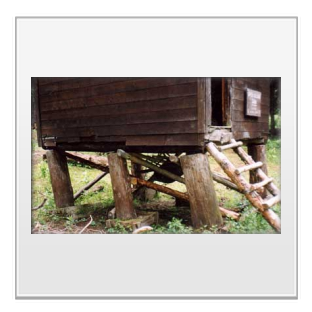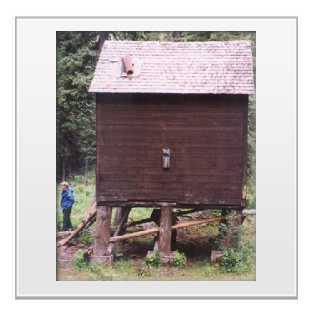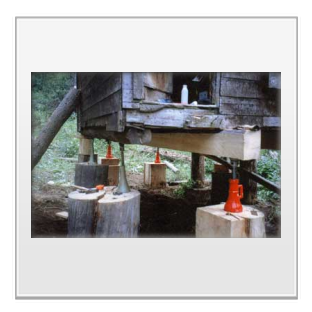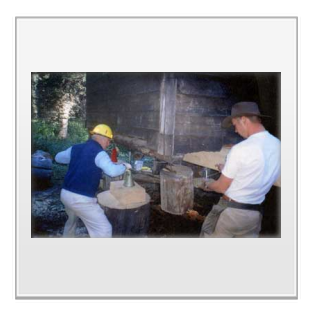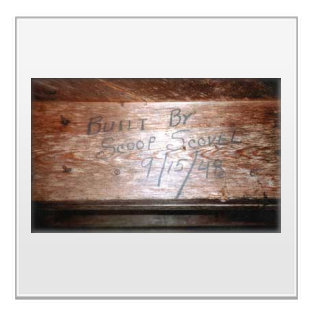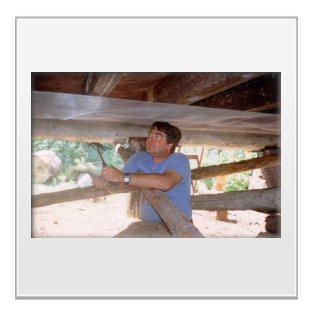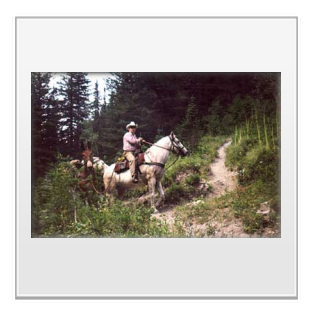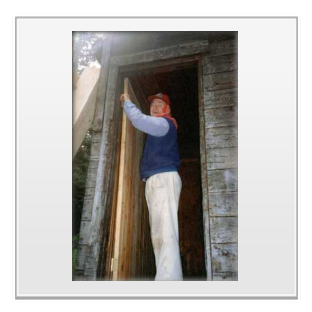Upper Holland Lake - Passport in Time
Main menu:
Previous Projects > States M-R
Upper Holland Lake Cabin PIT Project
Flathead National Forest, Montana, 2000
by Timothy Light, FS Archaeologist
Between August 6 and 11, we hosted a PIT project to restore the Upper Holland Lake cabin (Site 24MO463) on the Swan Lake Ranger District. We recruited four PIT volunteers: Gordon and Bunny Pfister (Renton, Washington), Yvonne Renz (Seattle), and Patrick Light (Missoula), who each contributed over 50 hours of time and labor to the project. Assistant Fire Management Officer Ted Richardson and I served as the project leaders. Justin Trodick, Mat Nerdig, John Day, and Dennis Burland, from the Swan Lake Ranger District fire crew, were key members of the team. Jay Deist and Billy Stewart, from FS law enforcement, with help from Ed Triplett, a local packer, packed all our supplies and materials into the cabin. The project could not have been completed without the assistance and support of all these individuals.
The Upper Holland Lake cabin is a small overnight cabin built for use by FS and Soil Conservation Service employees reading snow courses—measuring snow depth and water content to establish baseline snowpack information. Art Whitney and Scoop Scovel constructed this cabin and the cabin at Trinkus Lake in 1948. According to a 1999 study by Heritage Research Associates (HRA), Whitney designed the cabin to withstand 10 tons of snow. He cut the component parts at the ranger district shop, and then he and Scovel packed them into the site for assembly. The cabin measures 10 by 12 feet and stands on 4-foot-tall legs on concrete footers. The legs raised the cabin above the deepest snowfall to facilitate access to the building. Although the cabin did not meet the 50-year cutoff for eligibility for the NRHP when it was evaluated by HRA, it was suggested that upon reaching that age, it be considered eligible because of its association with the FS tradition of establishing simple, functional, overnight accommodations in remote backcountry areas. The cabin has now reached 50 years in age and can be considered eligible for listing in the NRHP. The goal of the project was to ensure the continued use and existence of this unique resource.
The major challenge was that settling of the footers had caused the legs to skew and the cabin to twist and take on a definite list to the northeast. Although the cabin itself was essentially sound, it was threatening to collapse because of the failure of the legs. Therefore the first order of business was to lift the cabin, reset the footers, and then either replace any rotten legs or cut off the rotten ends if possible. The cabin would then be lowered back onto the legs, which would be a foot shorter than before. The legs would be braced with log beams and angle brackets.
Other tasks were to reroof the cabin using 16-inch No. 1 Blue Label shingles with 5-inch exposure, duplicating the original; replace the old, worn-out door with one made in the shop last winter; rodent-proof the building by hanging hardware cloth under the floor joists; and then close up the building for the winter.
On Friday, August 4, Justin and Mat packed into the cabin with an Alaskan sawmill to remove several large spruce trees that were encroaching on the cabin. They then milled these into two 8–10-inch beams some 16 feet long to support the cabin while we reset the concrete footers and repaired or replaced the legs. All that week, Jay Deist and Billy Stewart, using Jay’s pack string, packed in gear and supplies, including the sawmill and eight screw jacks.
On Sunday evening, the volunteers and FS staff assembled at the Condon Work Center for a briefing that included project goals, safety issues, and volunteer signup forms. The cooking staff at Condon prepared a wonderful evening meal and sack lunches for the next day. Monday morning, we drove to the trailhead and hiked into the cabin, with gear and food transported by Billy Stewart on pack mules. We set up camp in a clearing by the creek and began work that afternoon. Justin and Mat worked hard all weekend, and by Monday afternoon, they had the cabin up on the beams, the beams resting on screw jacks, and one footer already leveled. It was late on Wednesday before we had the cabin back resting securely on its legs and no longer in danger of falling over.
Although there was much hard work involved in leveling the footers, cutting the legs, and dropping the cabin a foot and a half, there was only one moment when it looked like it was a goner. We had a rhythm going, got a little overconfident, and then got lazy resetting the jacks one more time. The result: the jacks weren’t level or straight up and down, the cabin started to lean, we tried to use the jacks to straighten it out but only made things worse, and then the cabin gave a lurch to the north. Only some quick action getting the bracing back in place helped us save the day. An hour or two later, it was all done, and the cabin was back in place, standing on its own on new legs and footers.
On Thursday and Friday, we reroofed the cabin, hung the new door, and made steps up to the cabin from spruce rounds. We then cleaned up the work site, tidied up the cabin, weather-proofed and rodent-proofed it, and jury-rigged a temporary roof over the stove jack to protect it through the winter. Currently, the cabin has no stove and is not ready for use. Ted and his crew will make a stove this winter, and it will go in next winter, along with furniture and glass for the windows.
The FS provided meals, with the volunteers and staff sharing meal preparation duty. Because of the year’s extreme fire danger, we were unable to build fires for cooking or evening warmth or to burn the scrap wood and shingles from the cabin project. In fact, on our last full day, Thursday, we received word that the forest would be closed on Friday and that Billy and Ed needed written permission from Flathead Forest Supervisor Cathy Barbouletos to even come in to take us out. We’re very glad that Cathy gave the OK! Upper Holland Lake is a wonderful place, but it would have been a long summer with little to eat if we had had to stay. On Friday, we broke camp, and volunteers and staff hiked out and returned to the Condon Work Center. From there, the volunteers left for their homes. The gear came out on the mules. Volunteers contributed over 200 hours of labor. We thank them all heartily! We couldn’t have done it without them—and it wouldn’t have been as much fun!
